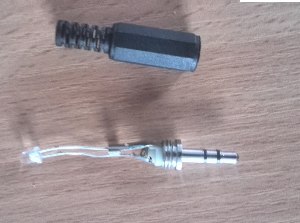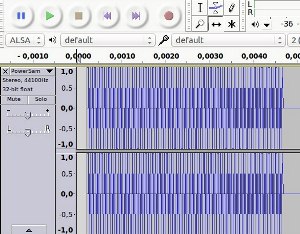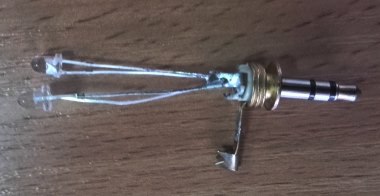Control any AV technology from your phone. IR transceiver for JACK 3.5
On September 26, HackDay # 32 started in the city of Penza. We decided to participate and implement an IR transceiver for JACK 3.5. The main requirement for our device was compactness and non-use of power sources.
We began our work by intercepting the signal from the control panel and studying its oscillograms. To receive a signal, we used a conventional IR diode:

For signal analysis, we used Audacity:
')

The received signal is extremely clean.
The diode works as a demodulator and we do not know on which carrier frequency the signal is transmitted. To solve this problem, remote.rtfms.com downloaded an example of the signal that Samsung firms need to submit to the TV and began to investigate with the help of the same program.

The stereo signal is amplitude-modulated to a sawtooth signal with a frequency of 20 kHz, inverse for each channel. Presumably, this is done because the JACK stably can generate a signal with a frequency of no more than 20 kHz and a different diode is connected to each channel. The signal is inverted so that the IR diodes are triggered on different fronts.
Changing the previously caught signal by this algorithm and making the transmitter specifically for this algorithm, we began to test.

Here the land is not used, the diodes are connected oppositely to the left and right channels.
The circuit worked, but we were not satisfied with the presence of 2 diodes. We decided to connect our receiver to this track, he also controlled the device. Consequently, their track is redundant and we left only one channel.
This solution only works on PCs and some smartphones from a distance of no more than a couple of meters. I really did not want to use an additional power source, but I had nowhere to go. To amplify the signal, we used a simple transistor switch.

The circuit has lost the ability to receive a signal. In the future, you can modify the circuit, we switched the receiver and transmitter.
For testing, we used a BBK DVD player and a JS 7300 Tricolor receiver. Our receiver is able to control these devices from a distance of about 15 meters (as long as the corridor was enough). We wanted to control the ViewSonic PJD 5132 projector from a smartphone during the demonstration of projects. It’s good that we decided to test the performance in advance - nothing really worked. The projector perceived our control signals only if you brought the transmitter close, which was problematic, as it hung from the ceiling.
We decided to play around with carrier frequencies. When changing the frequency, our test devices began to work similarly to a projector, therefore, it is impossible to superimpose an information signal on the same carrier. In the course of long efforts, we picked up the frequency and the demonstration did not fail.
A smartphone application that automatically modulated the read signal did not have time to do. We recorded ready-made sound tracks into the phone and styled the Activity in the same way as the control panel.
In the near future we will finish it and post it on Google Play in open access. Its main feature will be training device teams and the ability to create a personal remote control.
We began our work by intercepting the signal from the control panel and studying its oscillograms. To receive a signal, we used a conventional IR diode:

For signal analysis, we used Audacity:
')

The received signal is extremely clean.
The diode works as a demodulator and we do not know on which carrier frequency the signal is transmitted. To solve this problem, remote.rtfms.com downloaded an example of the signal that Samsung firms need to submit to the TV and began to investigate with the help of the same program.

The stereo signal is amplitude-modulated to a sawtooth signal with a frequency of 20 kHz, inverse for each channel. Presumably, this is done because the JACK stably can generate a signal with a frequency of no more than 20 kHz and a different diode is connected to each channel. The signal is inverted so that the IR diodes are triggered on different fronts.
Changing the previously caught signal by this algorithm and making the transmitter specifically for this algorithm, we began to test.

Here the land is not used, the diodes are connected oppositely to the left and right channels.
The circuit worked, but we were not satisfied with the presence of 2 diodes. We decided to connect our receiver to this track, he also controlled the device. Consequently, their track is redundant and we left only one channel.
This solution only works on PCs and some smartphones from a distance of no more than a couple of meters. I really did not want to use an additional power source, but I had nowhere to go. To amplify the signal, we used a simple transistor switch.

The circuit has lost the ability to receive a signal. In the future, you can modify the circuit, we switched the receiver and transmitter.
For testing, we used a BBK DVD player and a JS 7300 Tricolor receiver. Our receiver is able to control these devices from a distance of about 15 meters (as long as the corridor was enough). We wanted to control the ViewSonic PJD 5132 projector from a smartphone during the demonstration of projects. It’s good that we decided to test the performance in advance - nothing really worked. The projector perceived our control signals only if you brought the transmitter close, which was problematic, as it hung from the ceiling.
We decided to play around with carrier frequencies. When changing the frequency, our test devices began to work similarly to a projector, therefore, it is impossible to superimpose an information signal on the same carrier. In the course of long efforts, we picked up the frequency and the demonstration did not fail.
A smartphone application that automatically modulated the read signal did not have time to do. We recorded ready-made sound tracks into the phone and styled the Activity in the same way as the control panel.
In the near future we will finish it and post it on Google Play in open access. Its main feature will be training device teams and the ability to create a personal remote control.
Source: https://habr.com/ru/post/238491/
All Articles